CES 2004 Clement Perry
CES 2004
Clement Perry
Who was it that said this industry needs a new loudspeaker like a Moose needs a hat rack? Well seems as if none of these speaker builders are paying attention. Considering the photos below, designers such as Gryphon and Albert Von Schweikert introduced a balls-to-the-wall design, while only a few steps down the hall there’s the highly respected ESP Concert Grands back on the audio scene. Lets not forget the highly talented designer in Tierry Budge introducing his new Escalante Design loudspeaker. Seems CES 2004 was the Show of loudspeakers! Well, here’s to another installment to our CES report and there’s still more to come….stay tuned.
First on my list is the puniest but by no means the smallest sounding! The nameUltimate Monitor said more about the size of this designers ego than his loudspeaker. Yet, when speaking with Ultimate’s designer Dr. Karl Schuemann, I got the distinct impression this guys got both feet firmly on the ground. He simply believes in his product and I quickly understood why. A no-nonsense, straightforward type, Schuemann stated for the record “The Ultimate Monitor was designed for maximum achievable performance as a “transducer” in the purest sense: transforming an electrical wave into an acoustic wave with minimal distortions in both the amplitude and time domains. It achieves this by a “purist” approach.” The Ultimate Monitor ($12,000) is a 2-way, time-and-phase coherent, monitor speaker. The drivers used were chosen very carefully to allow extremely high performance, including deep bass, while not sacrificing the all-important midrange in any way. Woofers are dual ScanSpeak 6″  (15cm) Revelator units, the only drivers in the world that can meet this requirement. Tweeter is a ScanSpeak Neodymium soft-dome, chosen because it is extraordinarily good and also extremely small at the same time, thus meeting the geometry requirements between the 3 drivers. Crossover is at 4kHz, using a series first-order that Scheumann says took literally thousands of hours to bring to its final iteration. Cabinet is made in two pieces and the front baffle is CNC machined from solid 2″ thick aluminum alloy plate. The accessory BOMB modules are based on a filter known as the “Linkwitz Transform” and perform an exact mathematical inverse of the speakers’ natural low-frequency rolloff, simultaneously substituting a new rolloff an octave lower but precisely maintaining the system Q at 0.7. The system -3dB point in a typical room is 25Hz, while still being able to deliver RMS average SPL’s of approximately 100dB. I don’t know about all these claims. But this has to be one of the most cleanest and finest mini-monitors I’ve had the pleasure of hearing…especially under poor show room conditions. The sound was spectacular. I became immediately excited over how such a small design could sound so huge and well, promising. I guess if making this Ultimate Monitor was heard, wait until he tries selling it. At $12,000 per pair, I think they’re way overpriced based on their size. In terms of my short but thorough listening sessions I would have to state this loudspeaker is all the manufacturer claims it is. It sounded like an Ultimate Monitor.
(15cm) Revelator units, the only drivers in the world that can meet this requirement. Tweeter is a ScanSpeak Neodymium soft-dome, chosen because it is extraordinarily good and also extremely small at the same time, thus meeting the geometry requirements between the 3 drivers. Crossover is at 4kHz, using a series first-order that Scheumann says took literally thousands of hours to bring to its final iteration. Cabinet is made in two pieces and the front baffle is CNC machined from solid 2″ thick aluminum alloy plate. The accessory BOMB modules are based on a filter known as the “Linkwitz Transform” and perform an exact mathematical inverse of the speakers’ natural low-frequency rolloff, simultaneously substituting a new rolloff an octave lower but precisely maintaining the system Q at 0.7. The system -3dB point in a typical room is 25Hz, while still being able to deliver RMS average SPL’s of approximately 100dB. I don’t know about all these claims. But this has to be one of the most cleanest and finest mini-monitors I’ve had the pleasure of hearing…especially under poor show room conditions. The sound was spectacular. I became immediately excited over how such a small design could sound so huge and well, promising. I guess if making this Ultimate Monitor was heard, wait until he tries selling it. At $12,000 per pair, I think they’re way overpriced based on their size. In terms of my short but thorough listening sessions I would have to state this loudspeaker is all the manufacturer claims it is. It sounded like an Ultimate Monitor.
 Flemming Rasmussen, Gryphon Audio’s wizard, proudly poses next to his newest prototype loudspeaker design (price about $135,000). The system is a 4-way based on a unique Duelund Constant Phase X-over. (All drivers are in phase at all times at all frequencies). It uses 8 x 8” drivers in each bass column. The bass is driven by a custom designed Gryphon amplifier capable of delivering 1000W into a 4 ohm load (continuously). The amplifiers come with the unique Q control technology developed for the Cantata, ensuring a perfect match to the room. Gain, roll-off and other parameters on the active bass is controlled by a supplied remote control. The midbass/midrange/tweeter system uses 4 x 5″ midbasses and 4 x 5” midranges (from Cantata) plus a Scan speak ring radiator tweeter in custom designed 3 lbs. housing. The x over is pre-biased from the active woofer tower. (Cantata style).
Flemming Rasmussen, Gryphon Audio’s wizard, proudly poses next to his newest prototype loudspeaker design (price about $135,000). The system is a 4-way based on a unique Duelund Constant Phase X-over. (All drivers are in phase at all times at all frequencies). It uses 8 x 8” drivers in each bass column. The bass is driven by a custom designed Gryphon amplifier capable of delivering 1000W into a 4 ohm load (continuously). The amplifiers come with the unique Q control technology developed for the Cantata, ensuring a perfect match to the room. Gain, roll-off and other parameters on the active bass is controlled by a supplied remote control. The midbass/midrange/tweeter system uses 4 x 5″ midbasses and 4 x 5” midranges (from Cantata) plus a Scan speak ring radiator tweeter in custom designed 3 lbs. housing. The x over is pre-biased from the active woofer tower. (Cantata style).
All cabinets have a curved baffle precisely calculated to ensure REAL time alignment. The system is designed to be angled towards the listen in both the horizontal and vertical plane. The grill is supplied for protection and is an array of strings; a design first used by Sonus Faber (but used by Gryphon with permission of course). All drivers are custom designed and emphasis had been placed on low Q and lack of dynamic compression. Special developed surrounds that matches the curve of the driver diaphragm are being used and the fiber glass material is layer dampened. Dust caps are non-deformable low weight rigid material. The whole system is a sealed cabinet design. System response is 16 – 40.000 Hz within 3 dB depending on Q setting and room size. The choice a large number of smaller sized driver units instead of a few larger drivers, has been made to ensure a faster response and less “dragging”, thus ensuring a headroom and precision that is setting new standards.
The project was stared in 1992 with Mr. Duelund and Flemming Rasmussen and is finished by the same group of acoustic engineers that was behind the award winning Cantata Reference monitor system that has been claimed to set a new standard for small speaker performance. Conceptual and industrial design is as usual by Flemming E. Rasmussen.
The system is offered in a number of finishes only limited by imagination and depth of pocket.
 Allen Chang of Golden Sound introduced his new line of loudspeakers in the SP-100($12,800). Standing a very sleek 6 1/2 feet tall, and weighing in at 136 lbs, and using ten custom made drivers of varying sizes per side. I should add, they were quite cohesive sounding considering so many drivers (20!) per pair. Add to this home theatre scenario their SUB-100 ($15,000) which uses eight 8″ paper cone per side and adds an incredible sense of depth to the music, not to mention impact and dynamic shadings. All in all, I would have to nominate this loudspeaker as one of those biggest bang for the bucks around. Personally, for the price, I think they’re capable of going toe to toe against most, if not all, loudspeakers I’ve heard at the show in the areas of playing loud and powerfully without falling apart. Golden Sound also designed a smaller model in the SP-200($6,500) which uses six driver per side and looks like a great bargain. Amazing however, is their home theatre center channel modelC-100 ($7,000 shown in background). This is not your typical “oh lets place it on top of the television” center channel loudspeakers. This super center channel transducer uses twelve assorted driver compliments, again all custom, and weighs a ridiculous 165 lbs.
Allen Chang of Golden Sound introduced his new line of loudspeakers in the SP-100($12,800). Standing a very sleek 6 1/2 feet tall, and weighing in at 136 lbs, and using ten custom made drivers of varying sizes per side. I should add, they were quite cohesive sounding considering so many drivers (20!) per pair. Add to this home theatre scenario their SUB-100 ($15,000) which uses eight 8″ paper cone per side and adds an incredible sense of depth to the music, not to mention impact and dynamic shadings. All in all, I would have to nominate this loudspeaker as one of those biggest bang for the bucks around. Personally, for the price, I think they’re capable of going toe to toe against most, if not all, loudspeakers I’ve heard at the show in the areas of playing loud and powerfully without falling apart. Golden Sound also designed a smaller model in the SP-200($6,500) which uses six driver per side and looks like a great bargain. Amazing however, is their home theatre center channel modelC-100 ($7,000 shown in background). This is not your typical “oh lets place it on top of the television” center channel loudspeakers. This super center channel transducer uses twelve assorted driver compliments, again all custom, and weighs a ridiculous 165 lbs.

TG Audio/CTC Buildersdesigned and built/modified everything in this photo other than the speakers– theRockport Merak II/Sheritan II which sell direct for $29,500 The amps are monoblock versions of theParasound HCA-3500 with 40% more heatsink, twice the power supply and were voiced by Bob Crump (the complete story can be seen on the www.parasound.comwebsite as Curl, Thompson and Crump (CTC) had a hand at these bad boys) Boasting 400 watts and 135 amp, these monos will “drive the pee out of anything” shouts Curl. Probably the first time a high end product has been built by machine in Taiwan which keeps the pricing at about 1/3 what it would cost to hand build these here. In addition to the wires being from TG Audio a prototype transport and DAC was also making some mighty fine music. The AC was taken care of by the BybeeSucker line filter which Crump proudly states he’s been making “for about ten years.” The preamp was the CTC Blowtorch, something that everyone says is the best out there, but nobody has ever seen or heard….. (what a conundrum!). “It is a hotrod and the best we can do in a preamp…..We have sold about 25 to date is about all in the past five years…..” states crump.
The sound was pretty damn good considering show conditions and the break-in the speakers were going through…..Andy Payor (Rockport), I’m told, finished up the Merak/Sheritans just before the show so they only had minimum break-in. That said, the sound was very impressive sounding. I really liked the sense of space this room created. It certainly sounded a lot bigger than the cramped hotel bedroom it actually was.
At 66 inc hes tall, 1 inch thick and 33 inches wide and boasting a 60-inch, custom-made (0.3 mil thick) ribbon, the Gilmore Audio Model 2 is said to be one of the few home audio speakers able to reproduce live-concert sound levels and dynamics. Four, custom-made, free-air, long-throw, twelve inch, planar-dynamic-hybrid woofers move claim to move lots of air. The panel is made from Corian® and is essentially non-resonant at audio frequencies. The drivers is purported to exhibit exceptionally low distortion. Two models are currently available while there are many colors to choose from. I didn’t get a chance to hear them as they were only on static display with the beautiful model who stood readied for guys like me snapping photos. I would love the opportunity to hear such a loudspeaker since my favorite transducers were always the big open and airy sounding planars and electrostats. I bet there isn’t too much not to like about the Model 2.
hes tall, 1 inch thick and 33 inches wide and boasting a 60-inch, custom-made (0.3 mil thick) ribbon, the Gilmore Audio Model 2 is said to be one of the few home audio speakers able to reproduce live-concert sound levels and dynamics. Four, custom-made, free-air, long-throw, twelve inch, planar-dynamic-hybrid woofers move claim to move lots of air. The panel is made from Corian® and is essentially non-resonant at audio frequencies. The drivers is purported to exhibit exceptionally low distortion. Two models are currently available while there are many colors to choose from. I didn’t get a chance to hear them as they were only on static display with the beautiful model who stood readied for guys like me snapping photos. I would love the opportunity to hear such a loudspeaker since my favorite transducers were always the big open and airy sounding planars and electrostats. I bet there isn’t too much not to like about the Model 2.

Another great looking planar quasi ribbon was the Audia Soundlabs loudspeaker ($3,900). I got to tell you that I was impressed with the workmanship and price of this otherwise impressive sounding transducer. If you’re on a budget and want a lot of loudspeaker for your dollar don’t look any further than Audio Soundlabs. Now only if they get their website up and start answering their telephone. Keep an eye on for these (www.audiasoundlabs.com)


Fascinating was the exquisitely designed Chinese bred loudspeakers from Taiwan by newcomer Morkai Audio. Their Diamond F1 model (right) hails as their flagship at a modest $12,000 (considering its build quality, which by the way was superb). The model on the left is the B1 ($5,000) Most unusual features are their sculptured baffle and steel and acrylic [patent pending] stand that employs a single spike that stabilizes the entire loudspeaker. This approach is said to eliminate virtually all cabinet colorations and vibrations. Innovative with a slick design, the only thing I remember is the good sound coming out of this room. No matter what I played, or the volume, the sound remained coherent and easy to listen to. Signs that the design here is not just makeup. I was impressed.

Glacier Audio put on one helluva room demo. Tom Compagna, who was the only person present when I walked in, proudly showed his Quintessence Stealth SV ($50,000) which employs 9 drivers per side (15,12 10, 8, 2 X5″, 2 X 1″ Titanium Tweeter, 1 X 2″ Ribbon Super Tweeter) and boasts a single-ended lovers 94.5 dB of sensitivity. The 15, & 12″ are in a separate sub woofer enclosure and use a what Compagna describes as a “Compound Isobaric Alignment.” Specs, however dazzling, means nothing if the sound doesn’t match. The sound of this room was what I would call my second “Best at Show” surpassed only by the immensely sophisticated VR room (and only on the third day at that). Once you were under the hypnotic spell of the electronics here which included the MSB Super CD player and those huge Atma-Sphere mono amps ($28,000 pair), it was Game Over. I couldn’t get out of the room.
There’s no question that one of my main goals in attending any trade show is to reacquaint with the many personalities that can make this hobby so interesting. This CES was no exception. I bumped into many but not everyone that I hoped to. The folks I did happen to stop, pose for photos and chat with, this time around, looked a year older but, at the same time, less stressed. A good sign. My feelings are this industry is rebounding from its economic distressed state slowly but surely. There were many new manufacturers from abroad that shared that notion if not verbally, then certainly by their (first time) appearance here at the big dance. All in all, I must say this was a another great show!

Beetle Juice, neighbor and regular funnyman on The Howard Stern Show stopped by for a visit and poses for the ST cameras (with food in hand) before I departed for Vegas. Oh, in case you didn’t know, Beetle‘s a long time audiophile and is looking to upgrade. Beet’s only interested in short signal paths, mini-monitors and micro systems. Nothing too tall. Any suggestions? No jokes please.
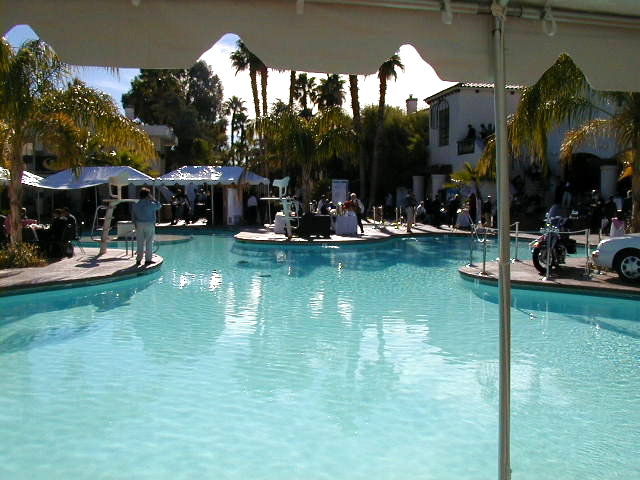
Las Vegas’ warm weather coupled with Alexis Park’s tropical surroundings was a warm and welcome sight coming from freezing east coast temperatures.
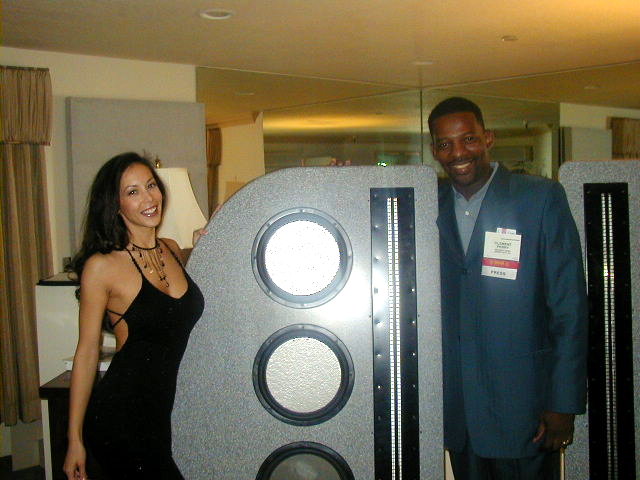
What a set of woofers! (couldn’t resist). Glacier Audio‘s beautiful model takes time out of her busy schedule to pose next to the Gilmore full range planar loudspeakers with yours truly.
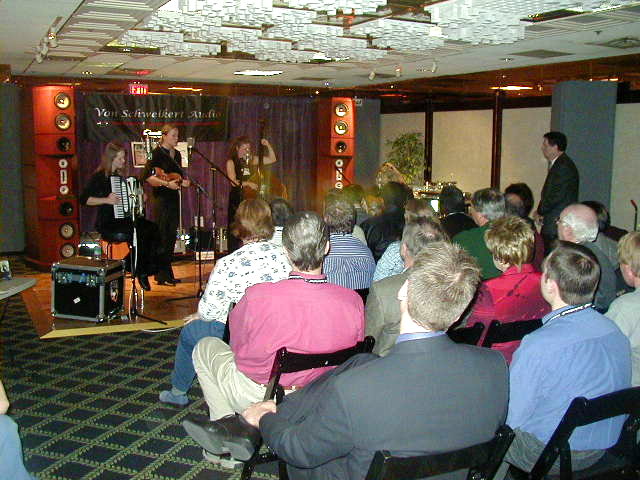
I gotta admit, the sound of Misty River, both in the Von Schweikert room (above), as well as during the free lunch concert held at the St.Tropez, turned out to be the Show of Shows. Considering how little I hear live Folk, Country and Bluegrass I found myself in full appreciation of their excellent musicianship. [Almost had my New York City Cool-Cat Card revoked when I almost let out a yodel-lay-hee-hoo!] These women can sing like angels and play instruments like the accordion, fiddle, acoustic bass and guitar like you wouldn’t believe. Don’t walk, run and get their latest CD entitled Misty River “Live at the Backgate Stage.”
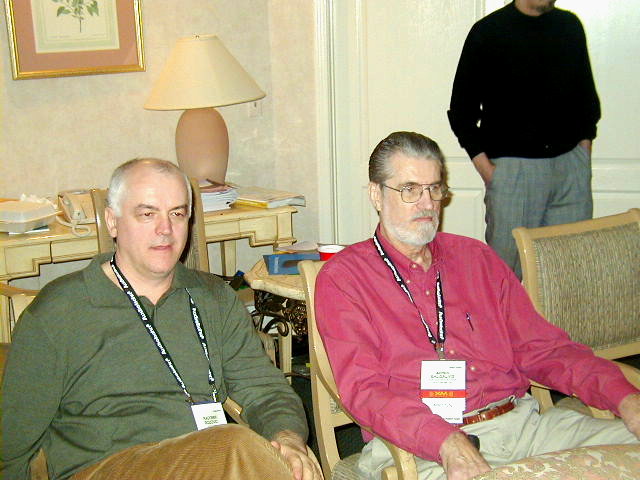
Tact Audio’s Radomir Bozovic and New York’s Audiophile Society guru Arnie Balgavis pause for a listen with Tom Campangna’s Quintessence Acoustic Loudspeaker.
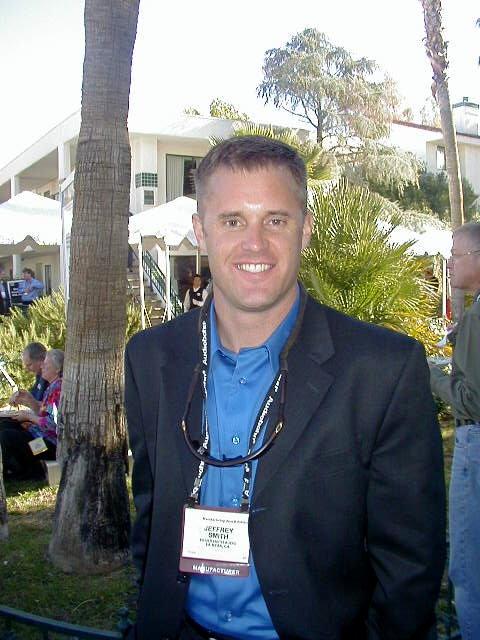
Caught up with Siver Smith’s Jeff Smith and as usual we had lots to talk about. Jeff’s recently returned from a tour of duty in the Middle East and we’re very glad to have him back in one piece.
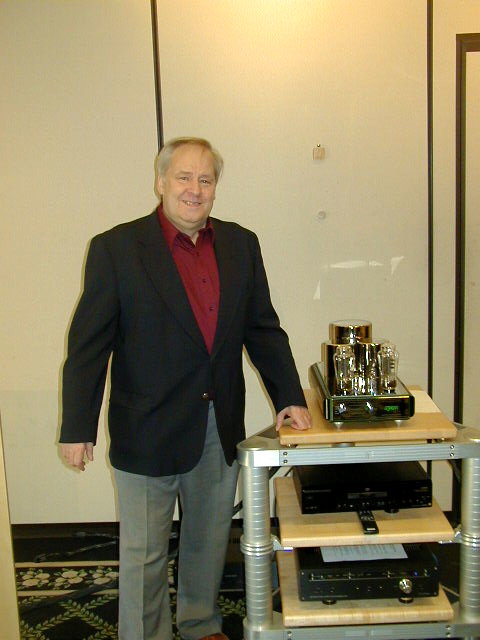
George Mark Audio Technologies’ George Bischoff stands proudly besides his new line of digital components in the Overture preamp/upsampling dac (located on the third rack). Stay tuned for a full review by Key Kim.
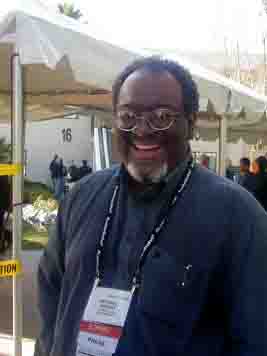
Mike Wright, a long time audiophile and our newest contributor walked the show very happy at all the new and exciting products displayed. Mike’s younger brother is Dave Thomas.

Clark Johnsen also paused for a brief chat and pose for our cameras.
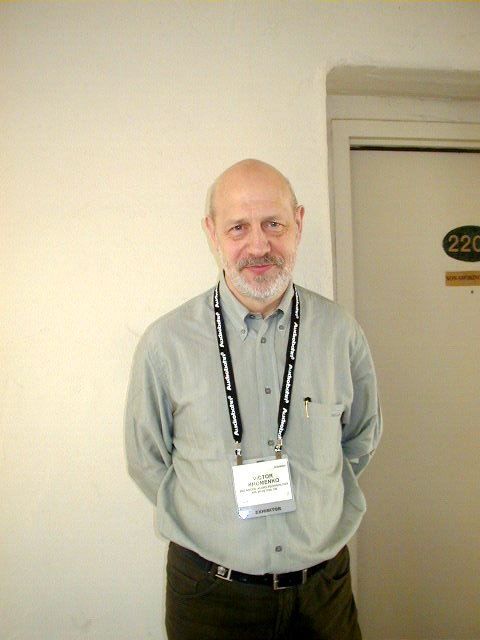
Balanced Audio Victor Khomenko had plenty to smile about. The sound of his electronics, as usual, was delightful.
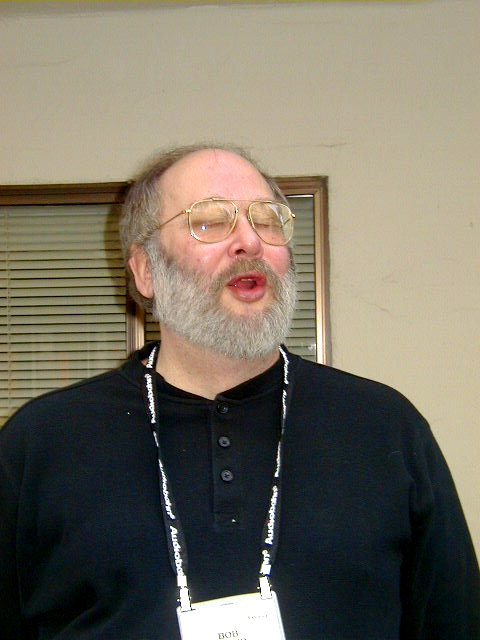
Bob Crump takes a moment to tell us all about the sound of his room. He wasn’t kidding either. The sound of his “Bob Crump” modified electronics were quite impressive sounding.
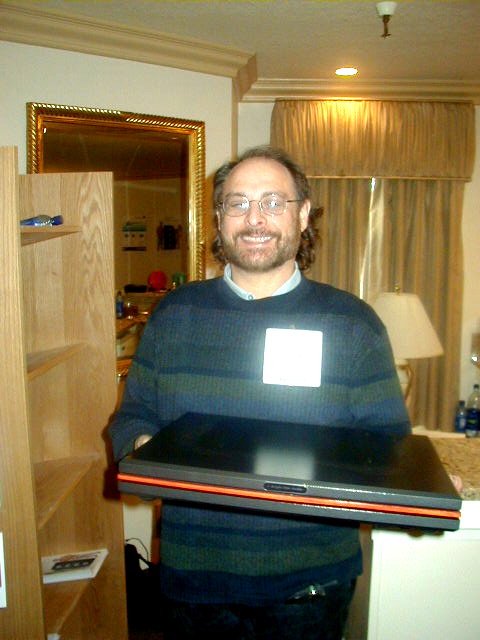
Bright Star Audio’s Barry Kohan proudly poses with his newest line of resonance control in hisIsoRock Reference 3 Isolation platform.
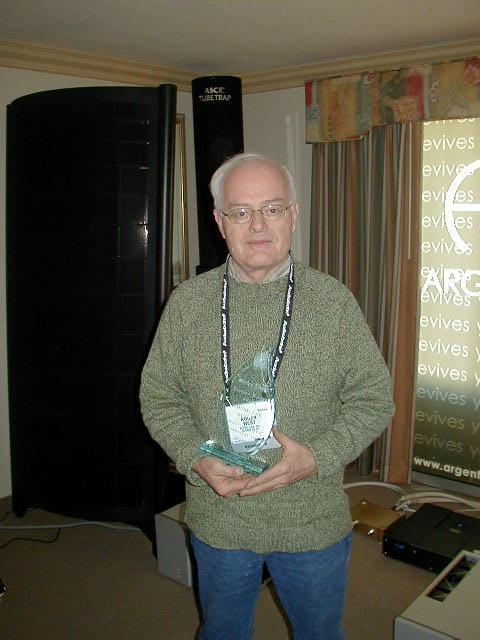
Sound Lab’s Roger West takes time out for our cameras to show off his Stereo Times 2003 Most Wanted Award

Dr. Hsu, famous for his subwoofers, was another happy face in the crowd. His room sounded quite good. For the money his products always stood out as a favorite of mine.
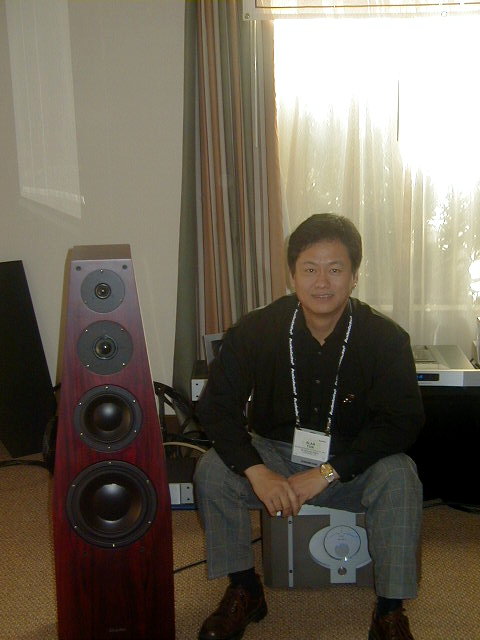
Silver Line’s Alan Yun poses next to his latest loudspeaker the Sonata Mk III. We hope to have a review sample sooner than later.
Audio maven Ken Kessler of Hi-Fi News stopped and chatted with me on the merits of a well made wrist watch. Ken knows a good movement when he sees one and was greatly impressed by the new Daniel JeanRichard Chrono ($2,300) I was sporting (right). Ken, an obvious aficionado sells and trades all the time and spoke of some nice wrist watches he owns and trades.
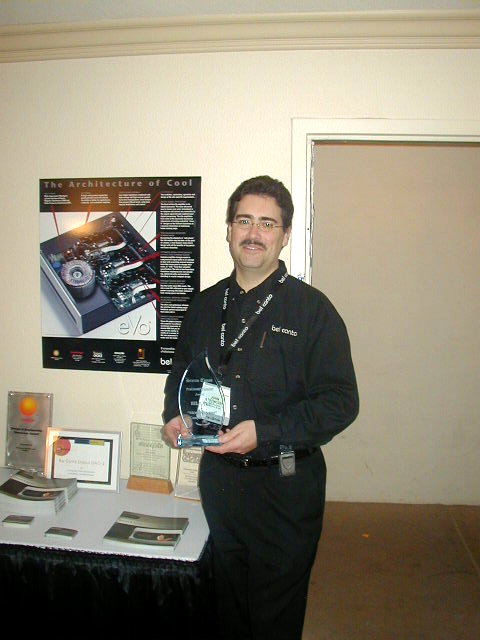
Bel Canto’s designer John Stronzcer smiles proudly with his Stereo Times Most Wanted Component Award for amplification.
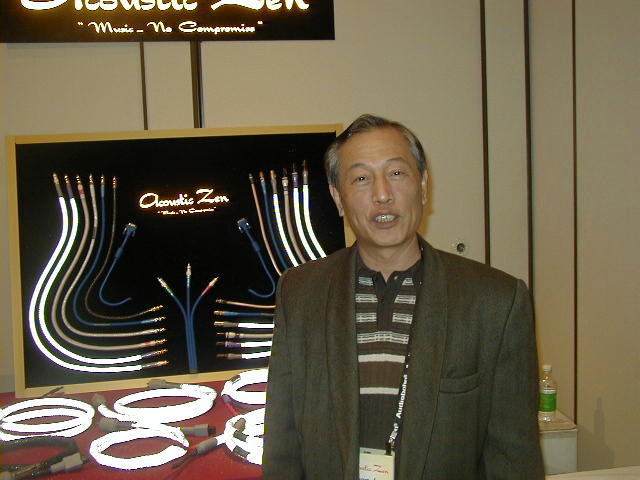
Acoustic Zen’s Robert Lee has to be smiling these days after what his cables did in the Von Schweikert Room. The sound was easily the Best at Show in my humble opinion.
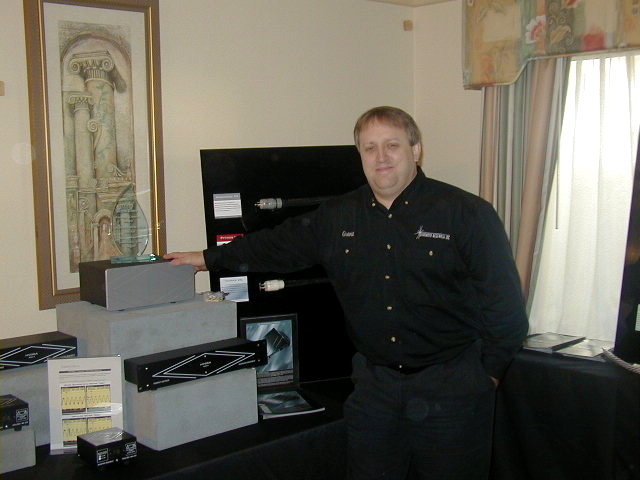
Grant Samulson of Shunyata Research smiles for our camera next to another Stereo Times Most Wanted Component 2003 Award. Shunyata’s new line of AC conditioners looked quite impressive and affordable.
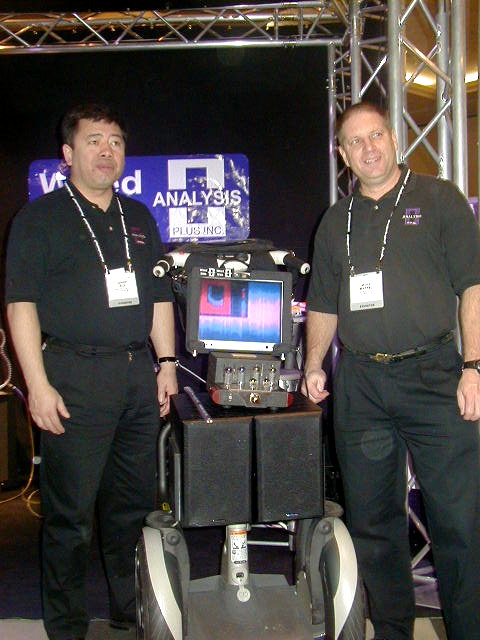
Analysis Plus’ team of Dr.Sun and Mark Markel pause for a photo with Mark’s newest toy at their booth.
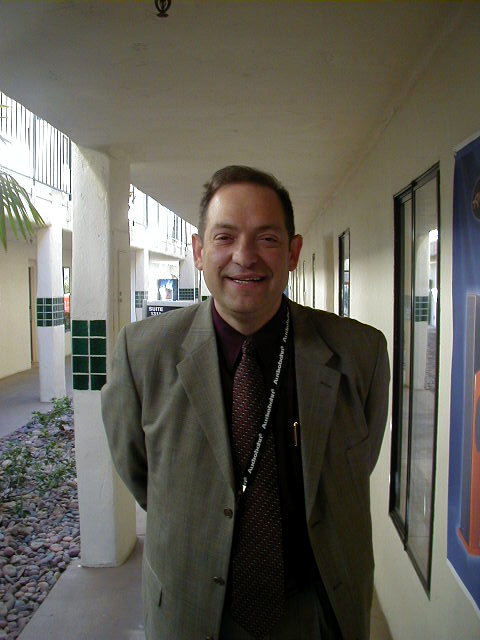
Audes’ Naum Dorkham was all smiles at yet another great show. The Audes Room, loaded this year with Balanced Audio Technology components, sounded better than ever! Congratulations.
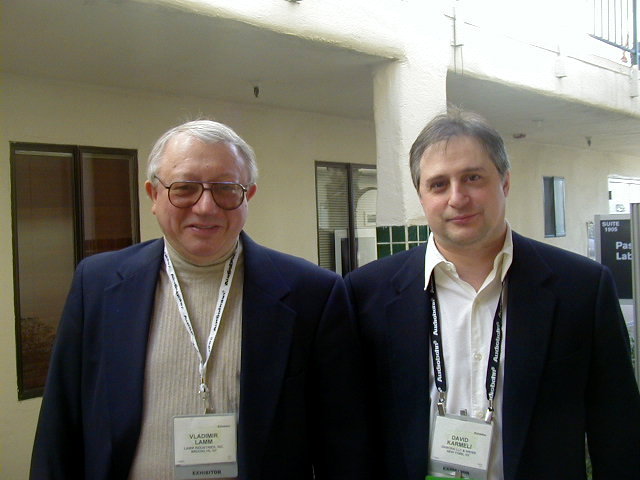
Lamm Audio’s Vladamir Shushurin and David Karmeli took time out of their hectic schedule to pose for our cameras.
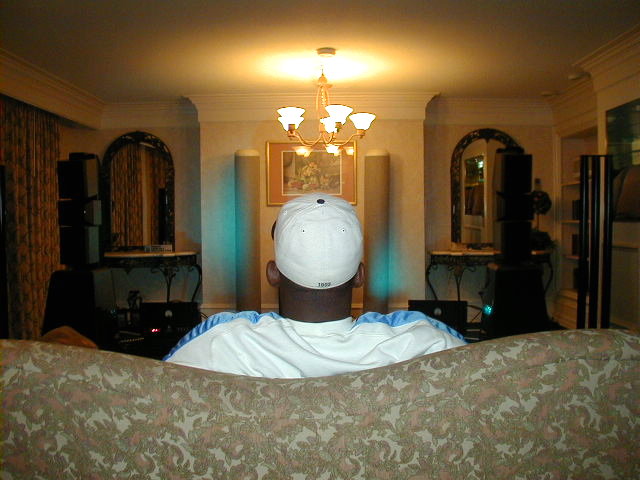
Nothing like listening when the lights are low and the music’s warm and inviting. The Quintessence Stealth SV loudspeakers and a couple of pair of Atma-Sphere amps sure did the trick, that’s for sure.
Stereo Times Masthead
Publisher/Founder
Clement Perry
Editor
Dave Thomas
Senior Editors
Frank Alles, Mike Girardi, Key Kim, Russell Lichter, Terry London, Moreno Mitchell, Paul Szabady, Bill Wells, Mike Wright, Stephen Yan, and Rob Dockery
Current Contributors
David Abramson, Tim Barrall, Dave Allison, Ron Cook, Lewis Dardick, Dan Secula, Don Shaulis, Greg Simmons, Eric Teh, Greg Voth, Richard Willie, Ed Van Winkle, and Rob Dockery
Music Reviewers:
Carlos Sanchez, John Jonczyk, John Sprung and Russell Lichter
Site Management Clement Perry
Ad Designer: Martin Perry



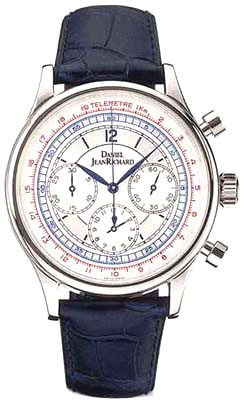



Be the first to comment on: CES 2004 Clement Perry